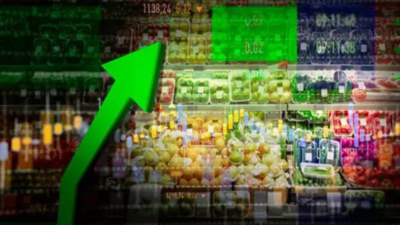
Retail inflation is expected to remain comfortably within the Reserve Bank of India's (RBI) projections for the first quarter of FY26, supported by a favourable base effect and continued deflation in essential food items, according to a recent report by Bank of Baroda.
As per news agency ANI, the central bank’s policy outlook currently pegs Consumer Price Index (CPI) inflation at 3.7% for FY26, with Q1 forecasted at 2.9%, followed by 3.4%, 3.9% and 4.4% in the subsequent quarters.In June 2025, the Bank of Baroda Essential Commodities Index (BoB ECI) recorded a year-on-year decline of 1.8%, deepening from a 0.6% fall in May. This marks the third consecutive month of deflation, largely driven by steep price corrections in vegetables and pulses, backed by improved production and favourable supply dynamics.Vegetables from the TOP category (Tomato, Onion, Potato) were key drivers. Onion and potato retail prices dropped sharply by 26.1% and 20.3%, respectively, while tomato prices fell by 24% year-on-year. Among pulses, Tur/Arhar plunged by 23.8%, with other varieties like Urad, Masoor, and Moong also reflecting sustained price drops due to better Kharif sowing, reported ANI.The report expects June CPI inflation to settle at 2.6%, providing room for the RBI to focus on growth-friendly policies.
“The outlook for inflation remains comforting for now, as it has the handholding of a favourable statistical base,” the report stated, adding that July could see similar trends.On a month-on-month basis, the BoB ECI saw a nominal 0.6% increase in June. However, the seasonally adjusted figure dropped 0.7%, indicating the sequential rise was largely seasonal. For instance, tomato prices jumped 36.1% from May, the highest since October 2024, due to monsoon-linked supply shifts.
Onion prices were stable, dipping just 0.4% in June after a sharper drop in May.The report, however, cautioned that TOP prices usually begin to reverse upwards in June and July, and urged for strengthened supply chain infrastructure, including cold storage and localised clusters, to reduce price volatility.Contributing to a stable inflation environment is a strong start to Kharif sowing, which rose 11.3% year-on-year, led by rice and pulses. Improved monsoon distribution has also helped, with June rainfall reaching 109% of the Long Period Average (LPA) and key agri-states like Rajasthan, Gujarat, and Madhya Pradesh receiving surplus rainfall.With food prices easing and supply-side pressures under control, inflation remains well below the RBI’s upper tolerance band of 6%, giving the central bank a window to maintain its growth focus, the Bank of Baroda report concluded.

 5 hours ago
1
5 hours ago
1







 English (US) ·
English (US) ·